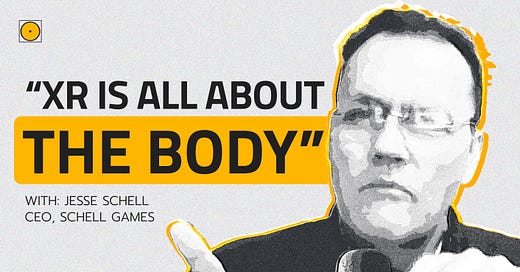Jesse Schell is the CEO of Schell Games, a studio of 150+ people’s team known for hits like Among Us VR and the I Expect You to Die trilogy. The studio over the years has worked on a diverse portfolio spanning entertainment, education, health, and theme parks, granting them an incredible track record for never having any lay off.
In this interview, Jesse shares:
How the main audience for XR is evolving
Why VR isn’t about 3D
His predictions for XR in the next 3–5 years
Before getting into the interview, I wanted to quickly introduce you to today’s sponsor Gracia AI. Gracia AI is the only app that allows you to experience Gaussian Splatting volumetric videos on a standalone headset, either in VR or MR.
It is a truly impressive experience and I recommend you to try it out right now on your Quest or PC-powered headset.
Interview with Jesse Schell
Mixed reality has come a long way. Has it lived up to your expectations?
Jesse Schell: It’s definitely gone the direction I expected. Video pass-through is dominating MR, and I saw that shift coming 8 or 9 years ago when I first saw a demo from Totem, which Apple later acquired as part of Vision Pro.
The key thing about video pass-through is the edges. In optical pass-through systems like HoloLens or Magic Leap, you can see beyond the edges of the display, which breaks immersion. Video pass-through doesn’t have that problem, and it’s way cheaper and more powerful.
That’s why I predicted that the 2020s would be the decade of video pass-through and the 2030s will be when optical pass-through really takes off.
Beyond the tech, what about the content? What experiences do you think MR is best suited for?
Jesse Schell: The biggest challenge for MR has always been the killer app problem. For VR, the killer app is obviously games. But for augmented reality? No one’s quite figured it out yet.
I have two theories about where the killer app for MR will come from:
- For adults, it will be telepresence. Moving beyond Zoom to something where people feel physically present in the same space.
- For kids, I believe MR will become a predominantly children’s medium. Kids love playing physically in the real world, and MR allows for that in a way screens don’t.
One of Quest’s best-kept secrets is that it works surprisingly well outdoors. That’s why I predict that by 2030, the dominant use case for MR will be children’s play, not productivity, not fitness, not work.
So you think MR’s biggest audience will be kids?
Jesse Schell: Yeah, I do. Kids naturally interact with the real world. They play tag, hide-and-seek, and pretend games where the real world and the imaginary blend together. Mixed reality is perfectly suited to that kind of play.
We’re already seeing MR games that work great outdoors, like Spatial Ops. Sure, Meta gives warnings about playing outside, but that’s mostly for legal reasons. I think people will overcome those concerns, and by 2030, MR will be a normal part of kids' playtime.
You’ve worked on some of the most successful VR titles. What’s the biggest lesson from those experiences?
Jesse Schell: If you’re serious about VR or MR, you have to start with the body.
A lot of people misunderstand what makes VR powerful. They think it’s about 3D graphics or depth perception, but it’s not. The real magic of VR is that your body becomes part of the experience.
If a VR game doesn’t involve your body in a meaningful way, you have to ask: Why is this even in VR?
That’s a great insight. How did that philosophy shape your approach to Among Us VR?
Jesse Schell: At first, we were skeptical about bringing Among Us to VR. The original game is 2D and mostly about typing, which doesn’t naturally translate to VR. But as we explored it, we realized two things:
- Tasks in Among Us involve interacting with objects like pulling levers, pushing buttons. In VR, we could make those fully physical.
- Among Us is a game about trust and deception. In VR, people literally have to watch their backs. That’s a new kind of tension that doesn’t exist in traditional gaming.
We also knew that voice chat was critical. Players were already using Discord while playing 2D Among Us, so it felt natural to bring voice chat into VR.
All of that combined made Among Us VR feel like a perfect fit.
Launching a game with an existing brand is one thing. What about launching an original title?
Jesse Schell: That’s much harder. If you’re launching something new, it has to be immediately understandable. For example, Blade & Sorcery works because people instantly get "Oh, it’s a physics-based sword fighting game." But if your game needs a lot of explanation, it’s a tough sell especially in VR, where marketing is already challenging.
How has the merging of the Meta Quest Store and App Lab impacted you?
Jesse Schell: This was inevitable. Every digital store starts curated, then eventually throws the doors open: Steam, Nintendo Switch, and now Meta. When the Quest Store was curated, it was great for developers like us. We could keep prices higher, and every game got visibility. Now, discoverability is a huge challenge.
The big unknown is: Will the Quest Store evolve like mobile (dominated by free-to-play) or like Steam (premium games still thrive)? The young audience skews toward free-to-play, but VR development costs are way higher than mobile, so it’s unclear how sustainable that model is.
Beyond gaming, Schell Games also works in education and health. How do you balance those projects?
Jesse Schell: We divide our work into four businesses:
- Entertainment games
- Educational games
- Health-focused games
- Theme park & museum experiences
Having diverse revenue streams has kept us stable for 22 years with zero layoffs. The market shifts constantly, and we’ve learned to lean into emerging opportunities. For example, when the pandemic hit, our theme park projects instantly shut down. But instead of laying people off, we pivoted to health and education projects, which were booming.
Let’s talk AI. How is Schell Games using it today?
Jesse Schell: Right now, AI helps with internal processes, concept art, scripting, etc. But the real opportunity is in AI-driven games that wouldn’t be possible otherwise.
An example I can think of is AI-powered in-home storytelling. Imagine an MR game where a character knows your home’s layout, knocks on your real front door and even guides you through an adventure in your own house.
That kind of personalized gameplay requires AI. I think this will be a major genre by 2030.
Final question: What’s your biggest XR prediction for the next 5 years?
Jesse Schell: Telepresence will become a game-changer. Meta’s Codec Avatars are already incredible, and within 5 years, we’ll have realistic, emotionally expressive avatars sitting on our couches, watching TV with us, and chatting naturally. That’s when MR will start to replace traditional social interactions, not just in gaming, but in everyday life.
That’s it for today, and don’t forget to subscribe to the newsletter if you find this interesting.
See you next week









I agree with many predicts on futures . I am excited to explore spatial UX / XR as medium part . Hybrid definition of temporal and physical form from OG Dutch design academia. That’s said I am critical on anything especially involves kids . Already struggling with screen time limitation . I am super critical any digital tools my kids are using especially don’t pass negative treats / behavior for them … what’s best solution for me smart projectors . For many ( without Judging anyone ) we know that people will adapt , choose more convenient options , living situations , cultural / social norms will play factors . A lot to create & design be norm critical at the same time … how kids will engage with other kids outdoors ? How parents will engage with their kids ? What kind of UX / IxD ( HMI/HCI) is suitable ?